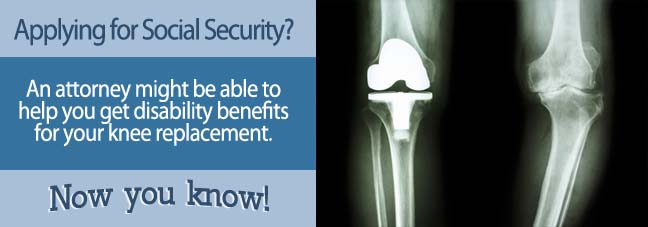According to the Centers for Disease Control, over 700,000 people get their knees replaced in the U.S. every year. Plastic and metal parts are used to replaces knees damaged from injury or arthritis.
Although a corrective measure, surgery can leave many people in chronic pain and unable to walk properly. If mobility problems prevent you from working, you may be found disabled by the Social Security Administration (SSA) and granted disability benefits under its grid rules system, particularly if you are over 50.
Grid Rules and Knee Replacement
The SSA evaluates many disability claims by applying their ‘grid rules’, which are a variety of factors that collectively help it determine whether you can reasonably be expected to maintain gainful employment.
These factors can include:
- Age
- Education level
- Your experience-based work skills
- Whether you have skills that can be transferred to another job
- Your residual functional capacity (ability to do certain types of work)
If you are over 50, your chances of approval increase because employers are less likely to hire older applicants for entry-level positions and the closer you are to retirement age, the less likely you are to be retrained for a different occupation.
Consequently, you may be found disabled even if you can technically do other work.
What Type of Work Can Someone Do With This Condition?
When you’ve undergone a knee replacement, you may find your mobility so limited that walking and even standing for longer periods of time can be impossible.
When you’ve always worked in a high-activity occupation, such as food service, construction work, or mail carrier, you may no longer be able to maintain gainful employment because pain and limited mobility prevent you from doing your job.

When you are over 50, your options for alternative employment are also limited, as older workers traditionally experience hiring challenges and problems transitioning into a different field.
If, for example, you are a 55-year-old waitress and worked in food service for years, the SSA will likely approve you for benefits, even if the grids suggest you could do other work, because your chances of be retrained for a more sedentary job are lower.
Meeting a Blue Book Listing
When it receives a disability claim, the SSA checks to see if the person’s condition meets a listing in the Blue Book, its guide to known disabilities.
Although knee replacement is not a listed condition, it can have complications that do appear in the Blue Book. They include:
- Section 1.02 – Major dysfunction of a joint(s) (due to any cause)
- Section 1.03 – Broken Bones in the Upper Body
If you have a major problem with your knee(s) after the surgery, making it difficult or impossible to walk and /or are not expected to be able for walk normally for at least 12 months, having a knee replacement could qualify you for benefits.
If you intend for apply for disability benefits for your knee replacement, it is a good idea to speak to a Social Security attorney or advocate first. Both professionals will help you understand the application process, the documents needed, and how to assemble the package that can get you the benefits you need.
If your claim is denied for any reason, your attorney or advocate can help you file an appeal and represent you at the hearing, improving the chances of being granted disability benefits to which you are entitled.